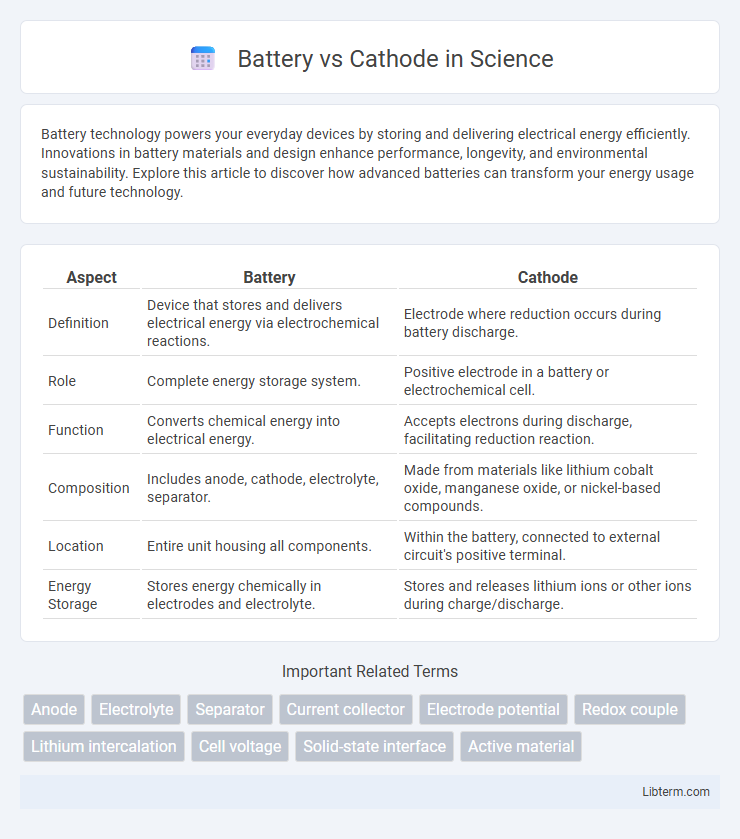Battery technology powers your everyday devices by storing and delivering electrical energy efficiently. Innovations in battery materials and design enhance performance, longevity, and environmental sustainability. Explore this article to discover how advanced batteries can transform your energy usage and future technology.
Table of Comparison
| Aspect | Battery | Cathode |
|---|---|---|
| Definition | Device that stores and delivers electrical energy via electrochemical reactions. | Electrode where reduction occurs during battery discharge. |
| Role | Complete energy storage system. | Positive electrode in a battery or electrochemical cell. |
| Function | Converts chemical energy into electrical energy. | Accepts electrons during discharge, facilitating reduction reaction. |
| Composition | Includes anode, cathode, electrolyte, separator. | Made from materials like lithium cobalt oxide, manganese oxide, or nickel-based compounds. |
| Location | Entire unit housing all components. | Within the battery, connected to external circuit's positive terminal. |
| Energy Storage | Stores energy chemically in electrodes and electrolyte. | Stores and releases lithium ions or other ions during charge/discharge. |
Introduction: Understanding Batteries and Cathodes
Batteries consist of cathodes, anodes, electrolytes, and separators working together to store and release electrical energy through electrochemical reactions. The cathode, typically made from metal oxides like lithium cobalt oxide or lithium iron phosphate, serves as the positive electrode where reduction occurs during discharge. Understanding the role of cathodes in battery chemistry is essential for optimizing performance, energy density, and cycle life in lithium-ion and other rechargeable battery technologies.
Defining Batteries: Structure and Function
Batteries consist of three primary components: the anode, cathode, and electrolyte, each playing a distinct role in energy storage and discharge. The cathode serves as the positive electrode where reduction reactions occur, accepting electrons during the discharge cycle. Its material composition directly influences the battery's voltage, capacity, and overall performance, making it a critical factor in defining battery efficiency and longevity.
What Is a Cathode? Key Role in Energy Storage
A cathode is the electrode in a battery where reduction occurs, serving as the primary site for electron acceptance during discharge. It plays a crucial role in energy storage by facilitating the flow of ions within the battery, directly impacting capacity and efficiency. Advances in cathode materials, such as lithium cobalt oxide or nickel manganese cobalt, enhance battery performance, longevity, and energy density.
Battery Chemistry: Types and Applications
Battery chemistry varies significantly between the anode and cathode materials, influencing performance, durability, and application. Cathodes commonly use lithium cobalt oxide, lithium iron phosphate, or nickel manganese cobalt oxide, each offering different energy densities and thermal stability suited for electric vehicles, portable electronics, or grid storage. Anode materials like graphite, lithium titanate, or silicon composites impact charging efficiency and lifespan, determining the battery's overall suitability for specific applications.
Cathode Materials: Innovations and Performance
Cathode materials are crucial in determining battery performance, with innovations in lithium nickel manganese cobalt oxide (NMC), lithium iron phosphate (LFP), and lithium nickel cobalt aluminum oxide (NCA) significantly enhancing energy density, lifespan, and thermal stability. Advanced cathode formulations incorporating high-nickel content and solid-state electrolytes are pushing the boundaries of electric vehicle range and fast-charging capabilities. Research on nanostructured cathodes and cobalt-free alternatives aims to improve sustainability while maintaining high capacity and cycle stability.
Battery Performance: Influence of Cathode Composition
Battery performance is significantly influenced by the cathode composition, as the choice of cathode materials directly affects energy density, cycle life, and thermal stability. High-nickel cathodes like NMC (Nickel Manganese Cobalt) and NCA (Nickel Cobalt Aluminum) offer superior energy density but require careful management to prevent capacity fade and thermal runaway. Optimizing cathode chemistry, including element ratios and doping strategies, enhances ionic conductivity and structural stability, resulting in improved overall battery efficiency and longevity.
Durability and Lifespan: Battery vs. Cathode Perspective
Battery durability primarily depends on the cathode material, as it influences capacity retention and resistance to degradation during charge cycles. Advanced cathode chemistries like lithium nickel manganese cobalt oxide (NMC) offer enhanced lifespan by improving structural stability and reducing capacity fade. Optimizing cathode composition directly extends the overall battery lifespan, making it a critical factor in long-term battery performance.
Safety Considerations: Battery and Cathode Interactions
Battery safety hinges on the chemical stability and interaction between the cathode material and the electrolyte, influencing thermal runaway risks and potential short circuits. Cathode materials such as lithium cobalt oxide (LiCoO2) or lithium iron phosphate (LiFePO4) impact the battery's thermal stability and resistance to oxygen release during overheating. Understanding these interactions is crucial for designing safer lithium-ion batteries with enhanced abuse tolerance and reduced fire hazards.
Environmental Impacts: Battery Production vs. Cathode Sourcing
Battery production involves complex processes that consume significant energy and raw materials, leading to increased carbon emissions and electronic waste. Cathode sourcing, particularly from minerals like lithium, cobalt, and nickel, raises concerns about habitat destruction, water depletion, and unethical mining practices in regions such as the Congo Basin and South America. Sustainable extraction methods and recycling innovations are critical to mitigating the environmental footprint associated with both battery manufacturing and cathode material sourcing.
Future Trends: Advancements in Battery and Cathode Technologies
Future trends in battery and cathode technologies emphasize the development of high-energy-density materials like solid-state electrolytes and lithium-sulfur cathodes, which promise enhanced safety and longer lifecycle performance. Innovations in cathode composition, including nickel-rich and cobalt-free materials, aim to reduce cost and environmental impact while boosting energy capacity. These advancements support the growth of electric vehicles and renewable energy storage by enabling batteries with faster charging rates and improved thermal stability.
Battery Infographic

 libterm.com
libterm.com